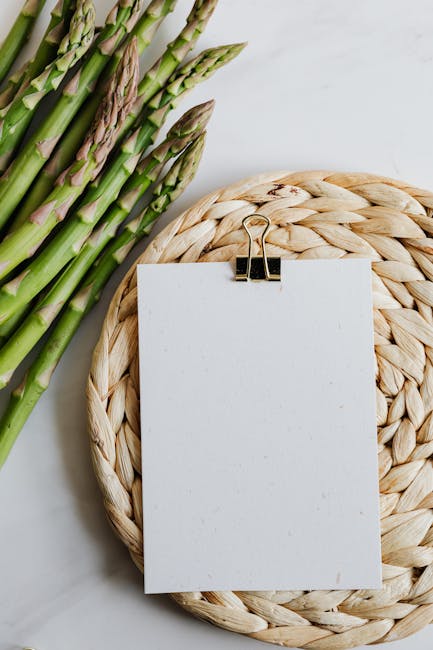Asparagus Recipes: From Simple Sides to Elegant Entrées
Asparagus, with its delicate flavor and vibrant green spears, is a versatile spring vegetable that lends itself to a wide array of culinary applications. From simple side dishes to sophisticated entrées, asparagus offers endless possibilities for the home cook. This comprehensive guide explores various techniques and recipes, highlighting the best ways to prepare and enjoy this delicious vegetable.
I. Simple Asparagus Side Dishes: Maximizing Freshness
A. Roasted Asparagus: This classic method brings out the natural sweetness of asparagus. Toss spears with olive oil, salt, and pepper, then roast at 400°F (200°C) for 12-15 minutes, or until tender-crisp. Experiment with variations by adding lemon zest, garlic, or herbs like thyme or rosemary. For a smoky flavor, roast on a grill pan.
B. Sautéed Asparagus: A quick and easy method perfect for weeknight meals. Heat olive oil in a pan over medium heat, add asparagus spears, and sauté for 5-7 minutes, until tender-crisp. Season with salt, pepper, and a squeeze of lemon juice. Consider adding a touch of butter at the end for richness. Shallots or garlic sautéed beforehand add depth of flavor.
C. Steamed Asparagus: A healthy and simple option that retains the asparagus’s nutrients. Steam asparagus spears for 5-7 minutes, or until tender-crisp, ensuring not to overcook. Season with salt, pepper, and a drizzle of good quality olive oil. A sprinkle of parmesan cheese adds a savory note.
D. Grilled Asparagus: The char from grilling imparts a delicious smoky flavor. Toss asparagus with olive oil, salt, and pepper, then grill over medium heat for 5-7 minutes, turning occasionally, until tender-crisp and slightly charred. A balsamic glaze drizzled over after grilling adds a delightful tangy sweetness.
II. Asparagus as a Key Ingredient in More Complex Dishes
A. Asparagus and Prosciutto Tart: A sophisticated appetizer or light lunch. Combine thinly sliced prosciutto with blanched asparagus spears on a puff pastry base. Drizzle with a light cream sauce and bake until golden brown. A sprinkle of grated parmesan cheese before baking adds a salty, nutty flavor.
B. Asparagus Risotto: A creamy and flavorful rice dish showcasing asparagus’s delicate taste. Sauté finely chopped shallots and garlic, then add Arborio rice and toast lightly. Gradually add warm broth, stirring constantly, until the rice is creamy and al dente. Stir in blanched asparagus spears during the last few minutes of cooking. Finish with a knob of butter and grated parmesan cheese.
C. Asparagus Frittata: A versatile and satisfying egg dish perfect for brunch or a light dinner. Whisk eggs with milk or cream, then add sautéed asparagus spears, cheese (cheddar, Gruyere, or goat cheese work well), and herbs. Pour into an oven-safe skillet and bake until set.
D. Creamy Asparagus Pasta: A comforting and elegant pasta dish. Cook pasta according to package directions. While the pasta cooks, sauté asparagus spears with garlic and shallots. Add a splash of cream and parmesan cheese, stirring until melted and creamy. Toss with cooked pasta and serve immediately. Toasted pine nuts add texture and flavor.
III. Asparagus in Global Cuisine
A. Asian-Inspired Asparagus Stir-fry: Asparagus works beautifully in Asian-inspired dishes. Stir-fry asparagus spears with garlic, ginger, and soy sauce. Add a touch of sesame oil for aroma and a sprinkle of toasted sesame seeds for garnish. Chicken or tofu can be added for a more substantial meal.
B. Mediterranean Asparagus Salad: Combine blanched or grilled asparagus spears with cherry tomatoes, Kalamata olives, feta cheese, and red onion. Dress with a lemon vinaigrette for a refreshing and healthy salad. Add chickpeas for extra protein.
C. Asparagus and Pea Soup (Vichyssoise variation): A creamy and flavorful soup that showcases the delicate flavors of asparagus and peas. Sauté onions and garlic, then add asparagus spears and peas. Simmer until tender, then blend until smooth. Season with salt, pepper, and a touch of cream. Serve chilled for a refreshing summer soup.
IV. Preserving Asparagus for Year-Round Enjoyment
A. Freezing Asparagus: Blanch asparagus spears for 2-3 minutes, then immediately plunge into ice water to stop the cooking process. Drain well and freeze in airtight containers or freezer bags.
B. Canning Asparagus: Canning requires proper sterilization techniques to ensure safety. Follow established canning guidelines for best results. Asparagus can be canned whole or cut into smaller pieces.
C. Pickling Asparagus: Pickled asparagus offers a tangy and flavorful alternative to fresh asparagus. Follow established pickling recipes, ensuring proper sterilization and acidification to prevent spoilage.
V. Tips for Selecting and Storing Asparagus
Choose asparagus spears that are firm, bright green, and have tightly closed tips. Avoid spears that are limp, wilted, or have woody ends. Store asparagus in the refrigerator, standing upright in a glass of water, or wrapped in a damp paper towel, to maintain freshness. Asparagus can be kept for several days using these methods.
VI. Dietary Considerations and Nutritional Benefits:
Asparagus is a low-calorie, nutrient-rich vegetable that’s a good source of fiber, folate, vitamin K, and vitamin A. It’s also a good source of antioxidants. For those following specific diets, it is naturally gluten-free and can easily be incorporated into vegetarian, vegan, and low-carb meal plans. However, individuals with kidney issues should consult their physician regarding asparagus consumption due to its high potassium content.





